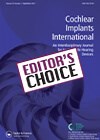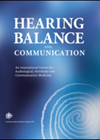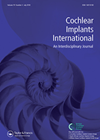
Journal Reviews
MRI scanning patients with cochlear implants and auditory brainstem implants
In the last five to six decades, MRI scanning has gone from physics experiments in Nottingham University through to Nobel prize-winning work by Sir Peter Mansfield and Paul Lauterbur, to a ‘routine’ imaging modality with an estimated 60 million MRI...
Cochlear microphonics in children
Cochlear microphonics (CM) are generated mainly from outer hair cells and are routinely tested in children with hearing loss in some parts of the world. In this retrospective study, the aim was to compare the cochlear microphonics features (mainly CM...
Can intraoperative electrically evoked auditory brainstem responses predict the outcome of cochlear implantation?
Electrophysiology during cochlear implant surgery remains an issue of debate among the various centres. In the present study, the latencies and quality of the eABR waveforms from 74 adult implanted patients were analysed. In addition, four children with severe cochlear...








